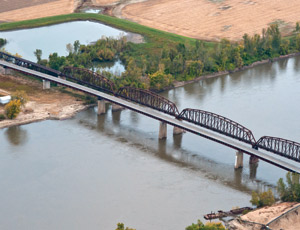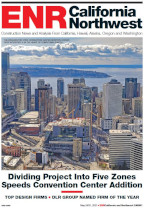America’s aging transportation and infrastructure sectors have been very good to the Midwest’s largest engineering firms, which once again claimed the top spots in ENR Midwest’s annual ranking of the region’s top design firms.

Even as U.S. construction activity slowed in March to a seasonally adjusted annual rate of $768.9 billion, just half of the $1.5 trillion considered healthy by economists, the Midwest’s largest engineers continued to outpace the industry, particularly firms specializing in roads, bridges and sewage-treatment plants.
And they’ve done so without much assistance from federal stimulus funding. “We’ve seen some stimulus funding in the Midwest, but it hasn’t been significant,” says Tony Bouchard, executive vice president with the Chicago office of engineer AECOM, whose specialties include sewage and transportation projects.
‘Been Hurt’
For some, including Omaha, Neb.-based architect-engineer HDR Inc., a firm specializing in transportation and building projects, diversification has been key to surviving the lingering impact of the recession. “We’ve been hurt,” says Tim Crockett, HDR senior vice president and central regional manager, “but we’ve also seen a real jump in our energy-related work, particularly projects involving transmission and distribution.”
AECOM has diversified by way of acquisition. Bouchard says regional revenue last year was buoyed by the acquisitions of New York-based construction manager Tishman Construction Corp. and Minneapolis-based architect/engineer Ellerbe Beckett, as well as by significant commissions in the aviation, health-care and water reclamation sectors.
The collective clout of the top 10 firms is perhaps best evinced by their collective revenue, which totaled $910.5 million in 2010. In 2009, revenue totaled $714.51 million.
Scan down further and it becomes clear that smaller firms, particularly those specializing in buildings, are merely holding their own. If many failed to see significant gains in 2010, they succeeded in sidestepping precipitous drop-offs in revenue.
“We’re flat,” says Mike Doiel, HDR marketing director for the firm’s buildings-related work. “The fact we’ve been able to maintain is great because the industry as a whole has not.”
Flagging Markets
Although health-care projects have been a boon to HDR and other firms in the region, returns have grown increasingly anemic.
“We’ve just come off a cycle that saw several health- care projects in the $1-billion range come on line,” says Faz Esahn, senior principal with the Chicago office of structural engineer Thornton Tomasetti Inc., whose recent projects include the OSF St. Francis Medical Center Children’s Hospital, a 440,000-sq-ft project in Peoria, Ill.
“There was a period when a lot of hospital administrators felt their facilities were becoming obsolete as a result of changing technologies, though perhaps that cycle is coming to an end,” Esahn says.
Diminishing public funds are draining other sectors, giving rise to concern among firms specializing in infrastructure and transportation projects.
“In states like Illinois, there’s only so much money to go around for infrastructure, entitlement and education projects,” says Crockett. “And believe me,” he adds, “everyone’s at the trough.”



Post a comment to this article
Report Abusive Comment